Maybe you had to be there for the full effect, but there was a
collective gasp from the group of us who had just been poking through the pond
flora to pick out all of the fauna -- little critters like bullfrog
tadpoles, dragonfly and damselfly larvae, water scorpions, water bugs,
whirly-gig beetles, scuds, mosquito fish, fishing spiders, isopods, crawfish,
and more --
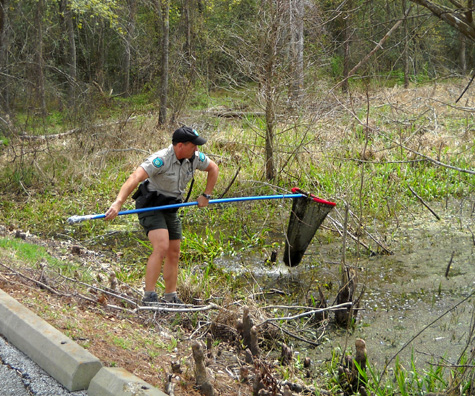
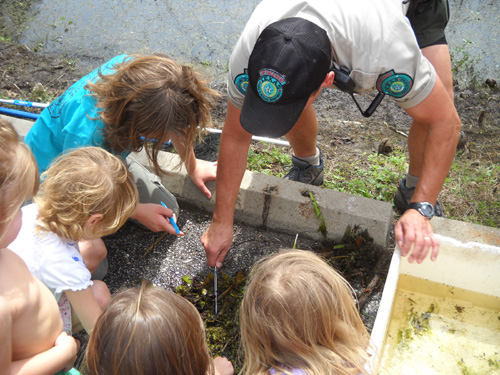
. . . when we went back inside the Nature Center and Dave fed them to the fish in the tank:
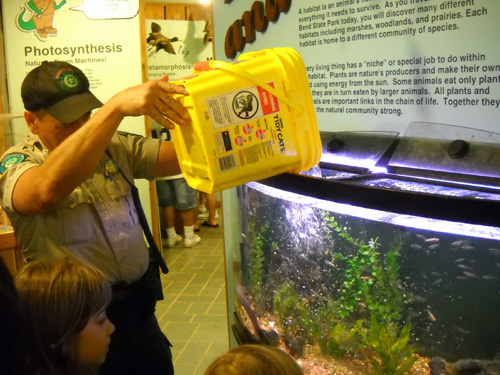
Although Dave had already warned us that the pond creatures would
be "giving their lives to science," watching the feeding frenzy
that ensued was a graphic lesson for young and old alike about
the constant predator-prey relationships among the living organisms in
the world.
Of course, if Dave hadn't fed these critters to the fish they would have
been preyed upon in their natural environment anyway; we
just wouldn't have seen it happen. There are numerous food
chains and food webs all around us in nature but we usually
don't think about them or see them except on a PBS nature
program as the lion runs down a wildebeest -- or when
your neighbor's cat catches a bird.
In a rich ecosystem like Brazos Bend State Park it's more
obvious as you wander around that something's always eating
something else in order to survive.
As Jim deadpans, "Snakes
gotta eat, too." That remark came after I saw a snake
eat some baby mice during a trail run in Virginia several years
ago. I felt sorry for the baby mice that were swallowed whole.
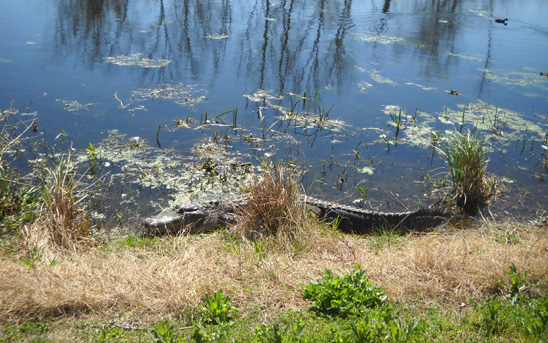
There are at least 300 adult alligators
(over six feet long) within the park + many younger ones.
They eat their food whole, too.
Many predators are themselves prey for
something bigger. What's cool is to realize
that some creatures you usually consider to be predators all
the time, like alligators, are also sometimes prey to one or
more other species.
As with grizzlies, they aren't always at the top of the
food chain! (Nor are we humans.) I'll talk more about that in
the next entry.
SPECIES DIVERSITY
The wildlife at Brazos Bend is both diverse and abundant, making
it a
great place to observe and photograph all sorts of critters.
Not only do the three main habitats of woodlands, wetlands, and
prairies support a large variety of
plant life (over 500 species), they also provide food and
sanctuary for numerous species of animals: over 300 kinds
of migratory and native birds, 39 kinds of dragonflies, more
than 25 species of mammals, 21 species of reptiles and
amphibians, and an unknown number of fish and other insects (I haven't
seen numbers for those).
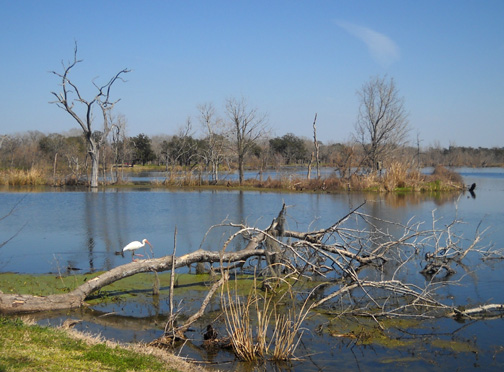
Out on a limb: an egret balances
on a fallen branch at the edge of Elm Lake.
All of these animals are protected within the park. They can eat
each other but two-legged visitors may not feed, harm, or harass them!
The only critters visitors can eat are the fish they catch. I
don't know if any deer hunting is allowed as it is on
certain winter days and under certain conditions at Huntsville
State Park.
In this entry I'll share photos of wildlife we observed at
Brazos Bend and some interesting information we learned from the
rangers and knowledgeable volunteers.
BIRD-WATCHING HAVEN
This is a great place for bird-watching, one of the most
popular stops on any Gulf Coast birding tour. The diverse habitat is
a haven for migratory and indigenous waterfowl, shorebirds,
wading birds, songbirds, and raptors. Some prefer the woodlands,
others the wetlands. Each ecosystem provides plenty of food and
places to rest.
The first time I walked around Elm, 40-Acre, and Creekfield
Lakes I was astonished at the number of birds I saw. That's the
day I took well over 200 photos in an eight-mile walk and quite
a few of them included birds. My favorites were the big snowy
egrets, great blue herons, and ibis of various colors.
Ibis are easy to spot because of their distinctive curved beaks:
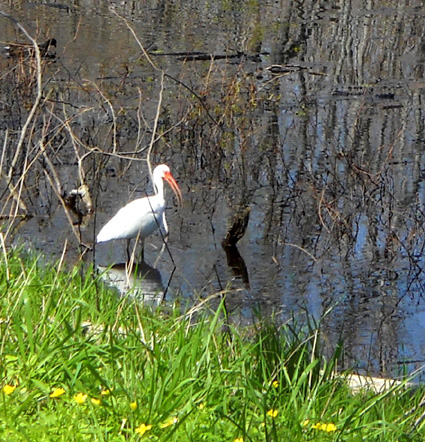
The park provides many interpretive signs that describe the
habitats and wildlife. Included are several that show and
describe the different kinds of birds, such as the one below
about various wading birds:
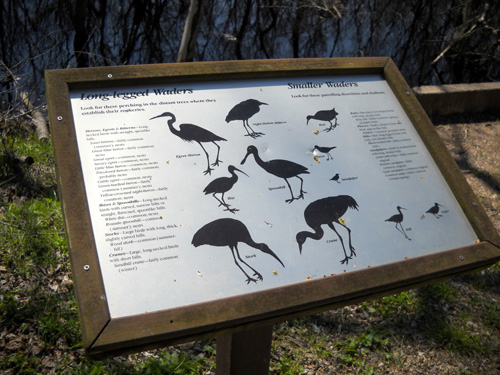
It was fun for me to learn some new bird species and be
able to identify them when I saw them. That knowledge made me
appreciate the wildlife even more.
Knowing some of the bird species also made me sound more credible
to visitors who asked questions when I was wearing my volunteer
shirt on walks around the park! That was one of the best parts
of being a campground host and general park volunteer -- helping visitors understand
what they were seeing so they could enjoy their park experience
even more.
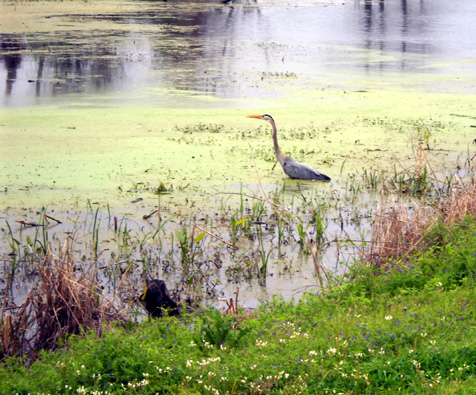
A great blue heron in another "Monet"
impressionistic setting
Brazos Bend attracts many professional and amateur bird
photographers. Most mornings I saw several folks with huge telephoto
lenses taking pictures of the numerous birds around Elm and
40-Acre lakes.
There are also guided bird walks several times a week,
especially when migratory birds are at their peak in the spring
and fall.
I often passed groups of various types of ducks that floated
near the shore, just a few feet from shore. Some would continue
their routine, oblivious to passers-by.
Others would fly
off, kicking up water as they got airborne, or silently paddle
farther out in the water:
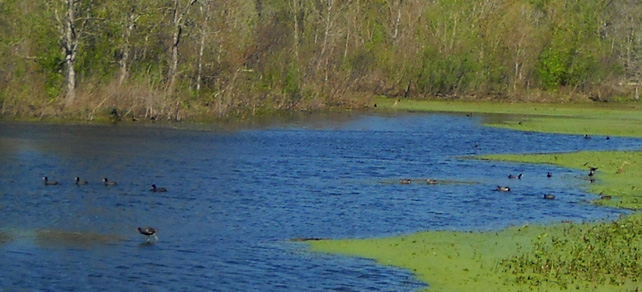
It's a good thing Cody isn't a real "duck dog" like his mother,
a champion duck retriever, or he would have gone nuts at Brazos
Bend! There were always lots of ducks around the lakes.
In the campground we could sometimes hear woodpeckers drilling
into trees
during the day and owls hooting at night.
"FEEL THE EARTH TURNING"
One evening I was walking around Elm Lake looking for a good
place to take pictures of the sunset. I ended up at the covered
fishing pier near the intersection of the Elm Lake levee trail
with the Spillway Trail.
It was a poor place for sunset pictures that evening, but a
terrific place to watch all the birds.
As I sat on one of the benches looking out over the water for an
hour or more, I became one with nature.

Shadows make a marbleized pattern in the
water next to the pier.
As the water lapped against the posts supporting the pier, it
looked and felt like I was in the middle of the lake on a boat,
rocking gently, not sitting stationary on the pier.
It was so peaceful and
soothing to listen to the frog choruses and the various bird sounds, to watch
the clouds morph into different shapes and the sky turn into
deeper shades of blue, to see a huge linear formation of
moorhens (below), a kind of duck, swim
in unison to the shore a hundred feet away, walk across the
levee trail, and slip into the marsh on the other side.
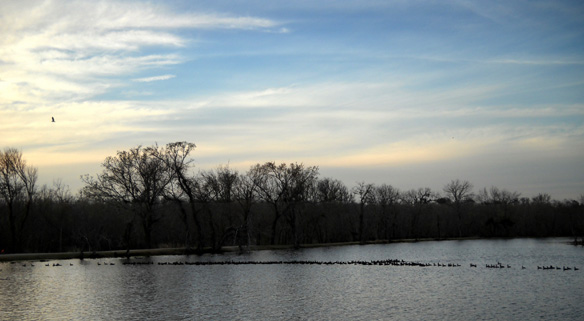
When an occasional group of noisy people walked by, my reverie was broken
for several minutes and I was annoyed by their intrusion into "my
world." Of
course, sometimes I'm guilty of that, too, like when I run or walk by
someone on a trail who has finally spotted the species of bird
he's been looking for all year . . . and the bird flies away!
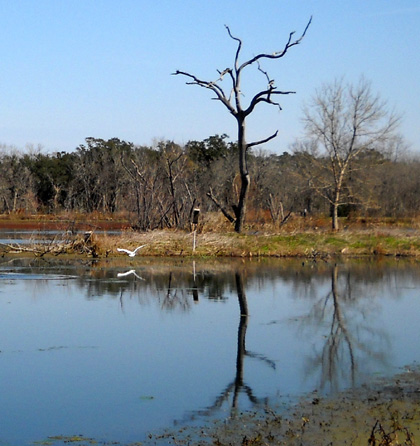
Reflections: a snowy egret takes flight over
Elm lake.
I really enjoyed that evening along the lakeshore. It does a
person good to stop and become part of the scenery. There's so
much to see and hear when you take the time to look and listen
closely.
A few days later, Ranger Dennis talked about this very thing at
the end of his bobcat nature talk. He encouraged us to take the
time to be still in the woods (or next to a lake) and become part of
the environment. Use all five senses to become more aware of the
surroundings. Animals get used to our presence if we're still
and they will come closer.
"You can almost feel the earth
turning," he promised.
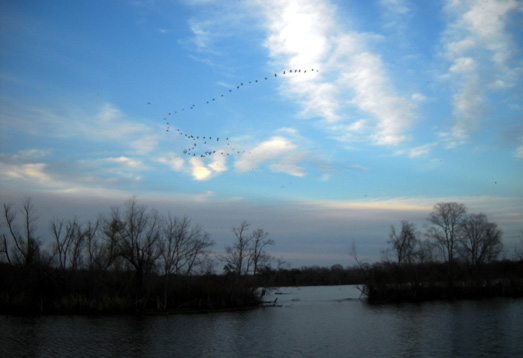
A swirl of birds flies overhead as day
turns into night.
Brazos Bend makes it very easy to sit and watch the wildlife.
There are numerous benches around the lakes and along the woodland
trails for visitors to rest or simply become one with the
environment. I wish now that I'd done it more often.
MAMMALS
White-tailed deer are the largest mammal at Brazos Bend and
there are lots of them around. They are
easy to spot from the park roads, especially between the
George Observatory and Nature Center, and along all the
backcountry trails.
Other mammals include bobcats, cougars, coyotes, gray and red foxes,
raccoons, squirrels, rabbits, armadillos, river otters, feral
hogs, and various rodents. We occasionally heard coyotes from
the campground at night but we never saw a coyote, bobcat,
fox, armadillo, or river otter at Brazos Bend (we've seen
armadillos at Huntsville SP). We did see raccoons, rabbits,
squirrels, rodents, and pigs.
We found out about the pigs when we noticed lots of mounds of
freshly-dug piles of dirt along the roadways and trails
throughout the park. At first I thought they might be the work
of armadillos,
since I'd seen smaller areas dug up by those critters at
Huntsville SP.
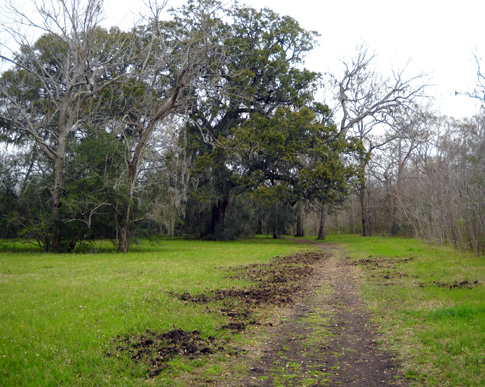
Dirt dug up by foraging pigs along the
Horseshoe Lake Loop.
Nope, the rangers said. The culprits were the feral pigs that have
become a major nuisance at Brazos Bend, tearing up the turf and
causing traffic jams a quarter mile from the park entrance gate.
It seems that folks are just about as interested in watching pigs from
their cars as they are watching bears, buffalo, or moose at
Yellowstone!
One day soon after our arrival Jim spotted a mama pig and four
babies foraging for food in a field near the entrance. Every
time I passed that area thereafter, I looked for the pigs. I'm a sucker for
baby animals; even baby pigs are cute.
I saw Mama Pig several times before spotting any of her piglets. One day
we were rewarded with seeing SIX babies close to Mom. Since no one was
behind us, I asked Jim to stop the truck so I could take a
picture:
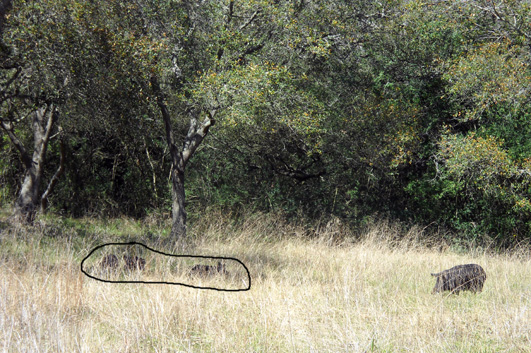
Mama Pig (right) and several piglets (circled) in the field,
right before they ran to hide from us
OK, so it's not a bear or buffalo or even a wild boar -- or
even a good picture of the piglets! They look like normal pigs that
wandered into the park from a nearby farm.
I was still interested in them, however, perhaps because they didn't
"belong" there.
Sometimes being a park volunteer has its downsides. One of them
was finding out that the rangers intended to relocate as many
pigs as possible this spring because of the damage they do to
the park (and the fact they don't "belong" there).
Unfortunately, we learned just what "relocating" entails.
Fortunately, this pig family was still around when we left at
the end of March.
PREDATORY CATS
We learned a lot about the wildlife in the park during the
public nature talks that were given
frequently at the Nature Center in March. Besides the pond life talk
mentioned above, we attended talks about bobcats, armadillos,
alligators, and snakes at Brazos Bend. We missed the one about
owls.
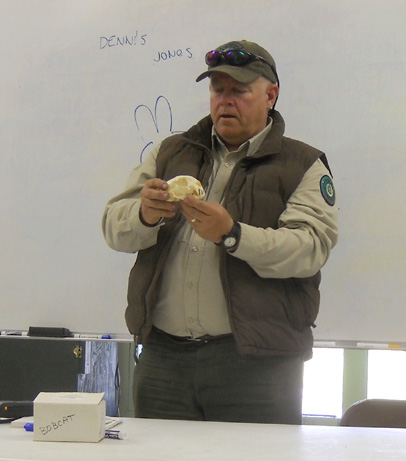
In the bobcat talk, Ranger Dennis J. (above, holding a bobcat
skull) gave his audience some
interesting
information about characteristics of predatory mammals in the
wild cat family such as
bobcats, cougars/mountain lions, lynx, ocelots, and jaguars. For example:
- Humans and other predatory animals can see black, white, and
shades of gray in the dark but not colors. Nocturnal hunters like
bobcats that are brown (or other colors) can sneak up on prey more
easily because the prey can't see them at night.
- Wild mama cats have a white "eye spot" on the back of their ears
so their babies can see them at night. Deer have white tails so they
can warn each other of danger. (I'd also guess it makes them more
visible at night, which may not be a good thing.)
- You can tell if an animal is predominantly predator or prey by the
placement of the eyes in its head. Predator eyes are more forward so
they can spot their prey. Prey eyes are more on the side of the head
so they can see predators coming.
- Scientists can estimate how many predators are in an ecosystem by
how many prey there are.
It isn't known how many bobcats, which are two to three times
the size of domestic cats, live in the park but the rangers know
they are present. They have a range of about 25 miles and come
and go from the park. They sleep in trees, hollow logs, and big
holes other animals have dug.
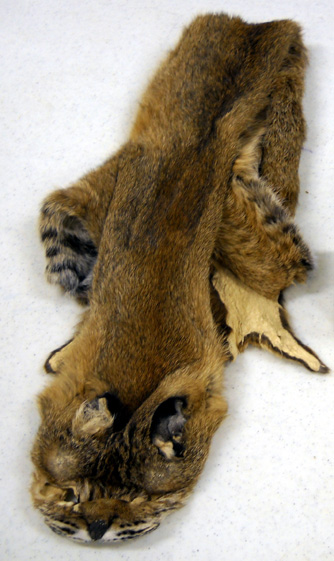
Bobcat pelt
Bobcats are carnivores that feed primarily on mice, birds,
rabbits, and grasshoppers, preferring "injured, sick, old,
young, and dumb" prey (i.e., the easiest to catch). They fear
humans and will run from them.
Cougars are bigger and more rare in the park than bobcats. Thank
goodness for that! They are more likely to attack humans and
dogs. They eat baby pigs, among other things.
Dennis said vaguely that there are "one or more" cougars living
at Brazos Bend. Their range can extend for a 200-mile
radius; they just come and go like the bobcats do.
Some ocelots, which are about the size of domestic cats, still
live in coastal regions of Texas and may visit Brazos Bend
SP.
Lynx usually live farther north and have bigger feet than
bobcats so they can walk better in snow. Some jaguars, the
third largest wild cat after lions and tigers, still live in SE
Arizona but haven't been seen in Texas since the 1800s.
AMPHIBIANS & REPTILES
Brazos Bend has twenty-one different species of amphibians and
reptiles.
Amphibians (Greek for "both lives") hatch from eggs laid in
water, then grow legs and other body features so they can live
on land. Like reptiles, they rely on external energy sources
like the sun to maintain their body temperatures. Common amphibians in the park are frogs, toads,
salamanders, and newts.
The only amphibian photos I have from BBSP are bullfrog tadpoles from
Ranger Dave's pond life workshop mentioned at the beginning of
this entry:
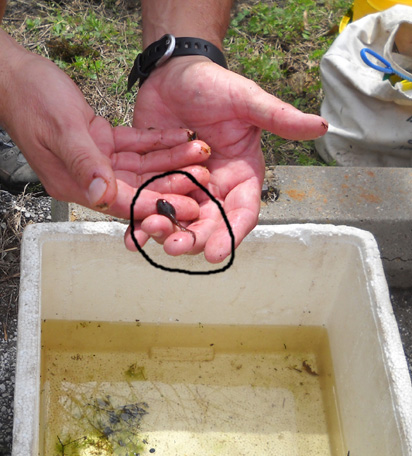
As you know, he already gave his life to science.
The tadpole, not Dave!!
When I think of reptiles I immediately think SNAKES. There are a
lot of other species that are also in this category of
critters at Brazos Bend State Park, including
lizards, alligators, and turtles.
Reptiles are a diverse bunch ranging in size from dwarf geckos
that are less than an inch long to saltwater crocodiles that
weigh more than a ton. That's a lot of croc! <smile> Their body systems vary quite a bit, too: circulatory, respiratory, nervous, digestive, reproductive, and
other systems. All reptiles have scales, although some are so
small they can't be seen with the naked eye. They breathe air
but some can remain under water for quite a while. They have a
"cold-blooded" metabolism and are ectothermic (their body
temperature is regulated by their environment). Most reptiles
lay eggs, but some give birth to live young.
The most popular reptile at Brazos Bend is the American
alligator. Visitors come from far and wide to see the 'gators.
I'll talk about them in the next entry.
TURTLE TALES
Turtles have been around for 215 million years and come in many
varieties. Some live on land; some are mostly aquatic. Most of
the turtles we saw at Brazos Bend live in or near the various
bodies of water. Although they can stay underwater for a while,
they breathe air and must surface periodically.
This one looks like he's walking on the water in the marsh
between Pilant and 40-Acre Lakes but he's actually perched on a
piece of wood floating in reddish aquatic plants:
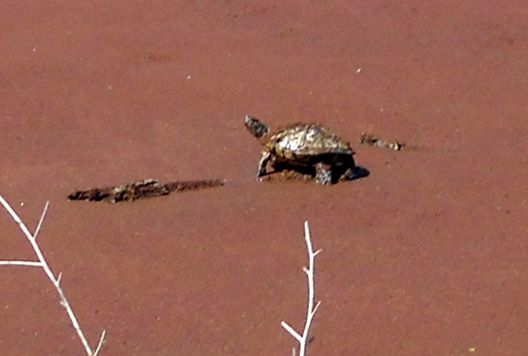
Like other reptiles, turtles are ectotherms, varying their
internal temperature by the ambient temperatures in their
environment. So just like snakes and alligators, they love to
sun themselves on spring days. Unlike snakes and alligators,
however, most of the turtles at Brazos Bend liked to bask on
rocks or logs in the water of the lakes and swamps. I never
noticed them on rocks or grassy banks on shore.
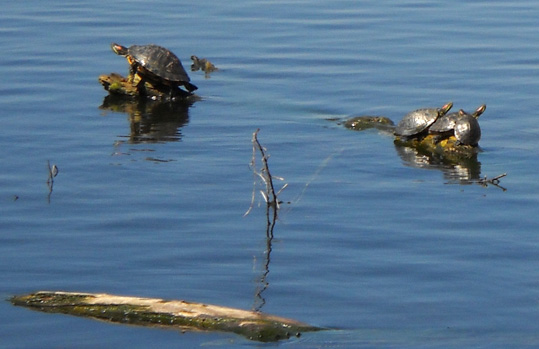
Turtles love to perch on anything they can
find in the water!
Notice the three crowded together on the
log to the right, above.
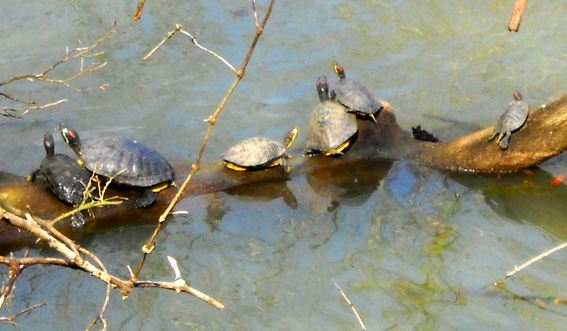
Although they are one of the American alligators' favorite
meals, I often saw turtles sunning themselves on the same logs
the 'gators were straddling out in the marshes or near the lake
shores, making them look like definite 'gator bait!
I took the next two pictures near each other at Creekfield Lake.
Notice the turtles perched close to the 'gators. These juvenile
'gators were only about three or four feet long so maybe the
turtles are confident they won't get eaten by these guys for a
few more years!
Look at the first picture carefully. Not only is there an
alligator on the log, there are also two more just barely
visible in the water on either side of Mr. Turtle!
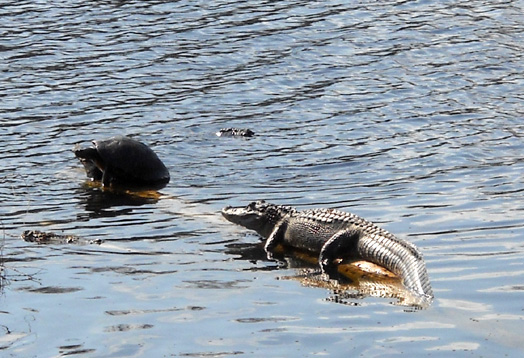
At least the turtle in the second picture
had the sense to get behind the two 'gators near him. Both of the
'gators have their mouths open as if they're laughing:
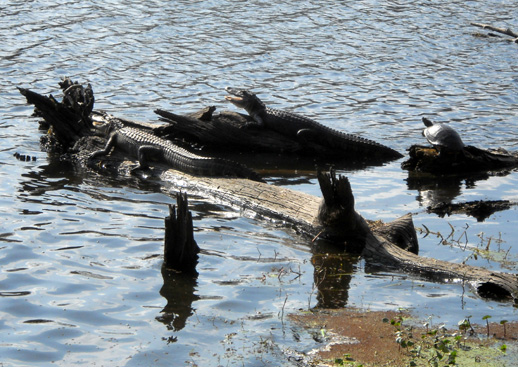
Many of the turtles amused me.
I loved to watch them.
Several times I deliberately chose to walk to one end of Hale
Lake simply to see how many turtles would be on a particular
log. This very long log is about twenty feet below the trail and
a bench that is strategically placed there. On a sunny day it's
fun to sit or stand in that spot and look down at all the
turtles lined up on the log! This is a long shot of the log,
which is in the water in the lower right side of the picture:
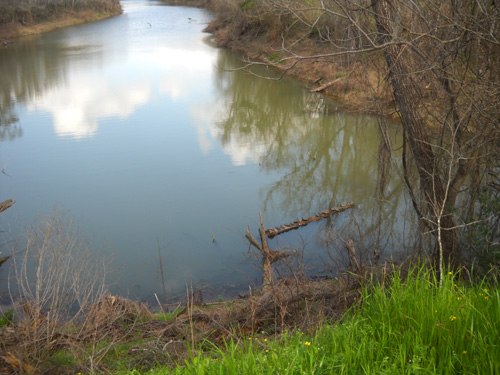
This is a close-up of the log with 16 or 17 turtles perched on
it. I've counted as many as twenty
still there after a few have slid off into the water when
they've heard me:
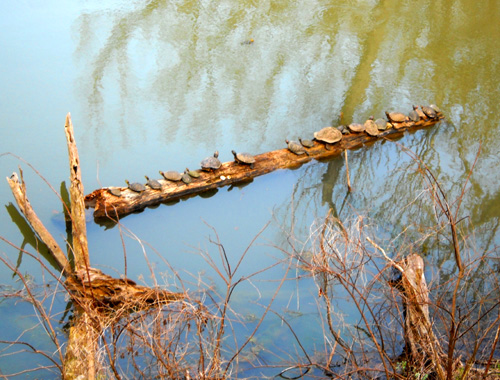
I smile every time I see that picture!
There were no turtle talks scheduled when we were at Brazos Bend
and I don't see any specific information on the park's website
about the types of turtles that live there. The ones I saw
varied in color and measured from about four inches across to
more than a foot across the carapace (top shell).
SNAKES GOTTA EAT, TOO
Brother Bill, this section is for you!
Just kidding. My brother hates snakes, and I don't think
he's even been bitten by one. He can just skip to the end
of this entry.
Jim's the one who should be paranoid about snakes after
his painful, expensive rattlesnake
bite in 2006. But there he
was, touching the smooth scales of the non-venomous snakes
commonly found at Brazos Bend during a recent nature
talk by Tom, one of the park's volunteers.
Despite all the trail running and hiking Jim and I have done in
the park this month, we've seen only three live snakes besides the dozen
on exhibit at the Nature Center.
The morning of Tom's lecture Jim saw
a colorful snake out on a trail but didn't
know whether it was venomous or non-venomous so he kept his
distance. He recognized it later that day during the nature talk -- a
Mexican milk snake, a type of king snake -- and was happy to find out it is
non-venomous. Since my photo of Tom holding a milk snake during
the nature talk turned out blurry, I borrowed this picture from
Wikipedia:
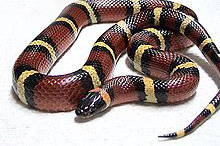
Jim says he doesn't look at the shape of the head or the pattern
of colors a snake displays, he looks to see if there are
rattles on the tail end! Yes, he knows not all venomous
snakes have rattles, but that's the kind that put the hurt on
him so it's imprinted on his brain now!
The Mexican milk snake almost looks like a venomous coral snake,
which also lives in southern Texas. Both have bands of black, red, and yellow but the positions
are different. You can use this little ditty to tell the
difference between harmless milk snakes and deadly coral snakes:
"Red next to black is a friend of Jack; red next to yellow
will kill a fellow."
This type of mimicry is good for the milk snake in that it may
scare away predators that think it's a coral snake, but I'm not
sure some folks would stick around long enough to remember the
mnemonic! There have probably been some milk snakes killed
needlessly because people mistook them for coral snakes.
When the Pilant Slough Trail opened up to foot traffic this past
week I saw a teenager photographing something off to the side
of the trail. I stopped to see what the attraction was. The kid
said it was a type of king snake and it looked almost like Tom's
faded milk snake to me (the colors are dull right before the
snake sheds its skin).
The snake was lying on the uprooted ball of a large
tree that had fallen over. Since the young man and I were both pretty sure the
snake was harmless
we took photos of it until it crawled away. I drew lines around
it in my
photo below:
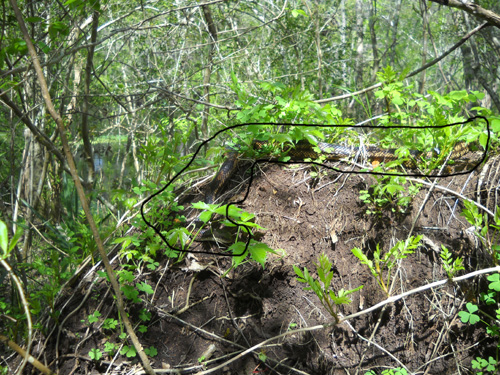
We could see about three feet of the snake but not its tail.
Information I later read said a milk snake gets up to about 30"
long. Other types of king snakes can grow longer. I know darn well the one I saw was longer
than 30"!
Here's a better picture of his head and eyes:
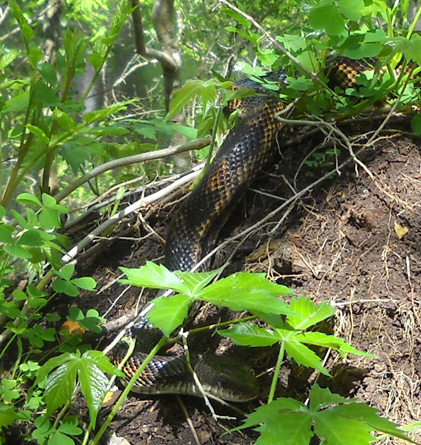
The milk snake in the Nature Center and the one Jim saw
are not as colorful as the one in the Wiki picture because they
are getting ready to shed their skins soon; the old skins
are more pale than the bright new ones that are uncovered in the
spring. Tom described how snakes rub their bodies on trees or
rocks to get the old skin to come off (inside out) when it's
time to shed them (when the scales start covering their eyes).
Here's a photo of a western pygmy rattlesnake at the Nature
Center. Its recently-shed skin is lying to the front and left of
the coiled snake. Note how the colors of the shed skin are more
pale than the new skin on the snake:
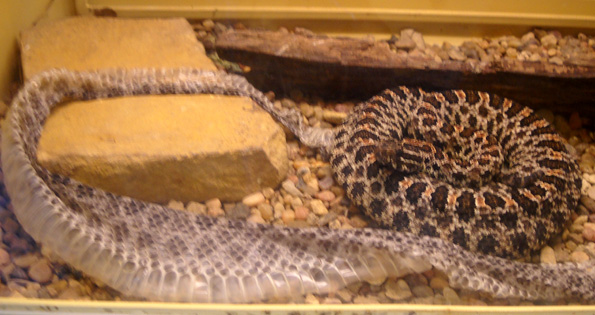
I like my colorful new skin much better
than that old drab one!
We learned lots of other interesting facts about snakes during
Tom's talk:
- There are no poisonous snakes, only venomous ones. Tom
described the difference between envenomation and poisoning.
- If you're bitten by a venomous snake and don't know what kind it
was, medical folks can tell by your symptoms whether it is venom from a pit
viper or another type of venomous snake. Pit viper venom attacks the
blood system and leads to internal bleeding, pain, swelling, tissue
necrosis, and discoloration. Those were Jim's symptoms from his
rattlesnake bite. Neurotoxic venom affects the heart,
lungs, nervous system, vision, and the voice box.
- Pit vipers have a heat-sensing pit on each side of their head
between the eyes and nostrils that senses the body heat of their prey.
- Venom subdues the snake's prey; non-venomous snakes use
constriction and/or sharp teeth to kill prey.
- Snakes don't chew their food but swallow it whole. Their
double-jointed jaws can open up to 180 degrees wide.
- Snakes can't hear; they feel vibrations instead.
- Some snakes bear live young; others lay eggs.
Tom showed us pictures and talked about the characteristics of
the venomous snakes commonly found at Brazos Bend: coral
snakes (red next to yellow bands), rattlesnakes (ten kinds in
Texas), cottonmouth AKA water moccasin ("raccoon mask" on head),
and copperhead (distinctive "Hershey's kisses" markings). The
nature center has several live venomous snakes on exhibit:

The canebrake rattlesnake, shown above, is protected in Texas
because it has lost so much of its habitat (tall canes at the
edge of creeks and lakes) and is a threatened species. See the
rattles on its tail?
The snake lecture got more interesting when Tom talked
about four different kinds of non-venomous snakes at Brazos Bend
-- because he had each of them wrapped around his arm
(separately) and came around so those of us in the audience
could see them up close and touch them if we wanted (most did,
including us).
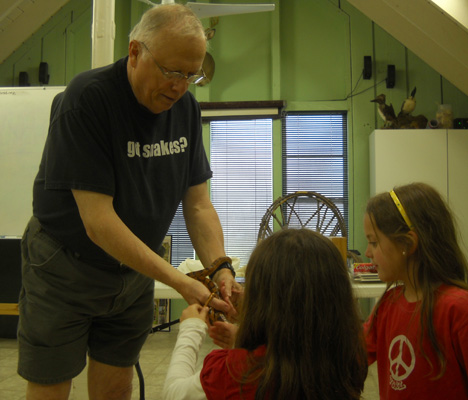
Two young girls touch a corn snake Tom is
holding.
Like most of the nature programs at Brazos Bend, there were more
little girls in attendance than little boys. I loved it! They
asked great questions and had no fear of touching the snakes
(above).
We got to see a Mexican milk snake, hog-nosed snake (I saw one
of those lying on a log near the shore in Elm Lake one day),
corn snake (scales on belly look like kernels of corn), and a
six-foot Texas rat snake AKA chicken snake that Tom had trouble
unwinding when it was time to put the snake back in its canvas bag for
transit back downstairs in the Nature Center:
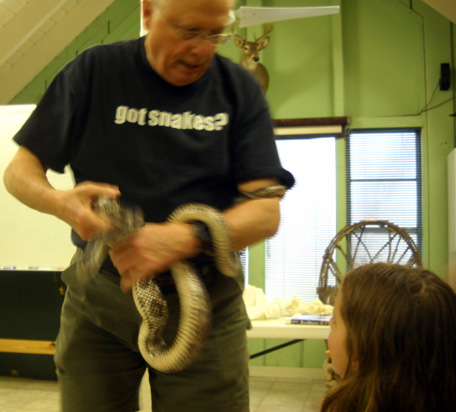
Rat snakes are interesting. They are excellent climbers and like
to hang out on tree limbs and barn rafters. So look up!! Farmers
hate 'em because they like to eat chicken eggs. They also eat
bird eggs and rodents.
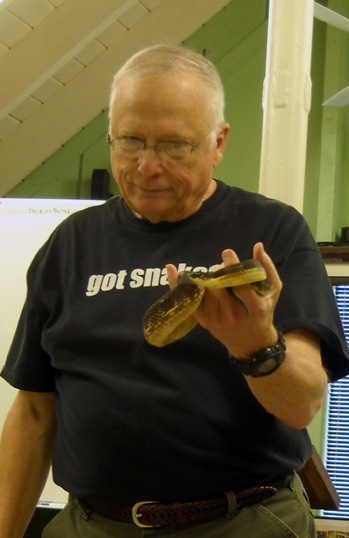
Tom holds a hog-nosed snake that is black on top with a
yellow belly.
The one I saw on a log in Elm Lake had that
coloration.
Hog-nosed snakes come in many colors but you can tell what they
are by their distinctive upturned snout. This is as close as I
can zoom in on that snake's nose without getting pixel-y:
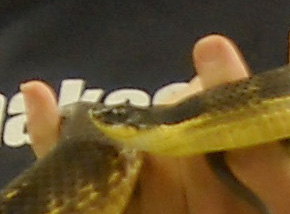
Hog-nosed snakes hiss loudly or play dead when threatened, so
beware; you might get a surprise if you pick one up that you
thought was dead!
Hog-nosed snakes like to eat toads. They either play dead and
wait until one comes within range before striking, or they use their nose to
locate a toad,
then sneak up very slowly toward their prey until they can catch
it.
A toad that thinks it may become dinner will puff itself up with air as large as
it can so it
looks more formidable. That might work with some predators, but
not hog-nosed snakes. They have special inner fangs that quickly deflate the
air-swollen toads as soon as they bite down on them.
As Jim would say, "Snakes gotta eat, too."
NEXT ENTRY
Both Jim and I have learned a lot about the critters that
inhabit Brazos Bend State Park and coastal Texas.
You can learn even more by checking out this online
wildlife identification
guide published by the Texas
Parks & Wildlife Department.
In the next entry I'll focus on the American alligators that
draw so many visitors to this park.
Happy trails,
Sue
"Runtrails & Company" - Sue Norwood, Jim O'Neil,
and Cody the Ultra Lab
Previous
Next
© 2010 Sue Norwood and Jim O'Neil